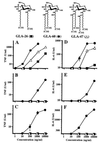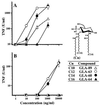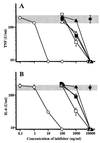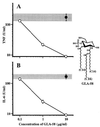Activity of monosaccharide lipid A analogues in human monocytic cells as agonists or antagonists of bacterial lipopolysaccharide
- PMID: 10569739
- PMCID: PMC97031
- DOI: 10.1128/IAI.67.12.6286-6292.1999
Activity of monosaccharide lipid A analogues in human monocytic cells as agonists or antagonists of bacterial lipopolysaccharide
Abstract
The lipid A portion of bacterial lipopolysaccharide (LPS) plays a central role in the production of endotoxic mediators. Different responses between human and murine macrophages to lipid A-like structures have been indicated. We investigated a series of structurally related monosaccharide lipid A analogues for their potency to activate human macrophage U937 cells and peripheral blood mononuclear cells for production of tumor necrosis factor-alpha and interleukin-6 compared with their potency to activate murine macrophage RAW264.7 cells. Two of the analogues were found to have sufficient potency to activate the human cells as well as the murine cells. These analogues comprise D-glucosamine, phosphoryl groups, and acyl groups of defined carbon chain lengths (C(14) and C(12)) in a ratio of 1:1:3. This ratio of molecular constituents is proportional to that of the complete disaccharide structure of lipid A (2:2:6). Other analogues with two or four C(14) acyl groups and with three acyl groups but including a C(10) or a C(16) acyl group, which are active to murine cells, showed no LPS-agonistic activity, but did show LPS-antagonistic activity, to human cells. An LPS-antagonistic analogue in the murine cells also showed antagonistic activity in human cells. These results reveal that lipid A analogues recognized as being LPS agonists by human macrophages have common structural features in monosaccharide and disaccharide structures which are more strict than those required for recognition by murine macrophages and that broad lipid A-like structures are recognized as being LPS antagonists by human cells but are recognized by murine cells as being either LPS agonists or antagonists.
Figures






Similar articles
-
Relationship of structure and biological activity of monosaccharide lipid A analogues to induction of nitric oxide production by murine macrophage RAW264.7 cells.Infect Immun. 1998 Dec;66(12):5792-8. doi: 10.1128/IAI.66.12.5792-5798.1998. Infect Immun. 1998. PMID: 9826356 Free PMC article.
-
Cell activation by monosaccharide lipid A analogues utilizing Toll-like receptor 4.Immunology. 2003 Sep;110(1):66-72. doi: 10.1046/j.1365-2567.2003.01709.x. Immunology. 2003. PMID: 12941142 Free PMC article.
-
Comparison of the effects of Salmonella minnesota Re595 lipopolysaccharide, lipid A and monophosphoryl lipid A on nitric oxide, TNF-alpha, and IL-6 induction from RAW 264.7 macrophages.FEMS Immunol Med Microbiol. 1998 Nov;22(3):263-73. doi: 10.1111/j.1574-695X.1998.tb01215.x. FEMS Immunol Med Microbiol. 1998. PMID: 9848688
-
Synthesis of lipid A and its analogues for investigation of the structural basis for their bioactivity.J Endotoxin Res. 2005;11(6):341-7. doi: 10.1179/096805105X76841. J Endotoxin Res. 2005. PMID: 16303089 Review.
-
Agonists and antagonists for lipopolysaccharide-induced cytokines.Immunobiology. 1993 Apr;187(3-5):303-16. doi: 10.1016/S0171-2985(11)80346-3. Immunobiology. 1993. PMID: 8330901 Review.
Cited by
-
Modulating LPS signal transduction at the LPS receptor complex with synthetic Lipid A analogues.Adv Carbohydr Chem Biochem. 2014;71:339-89. doi: 10.1016/B978-0-12-800128-8.00005-4. Adv Carbohydr Chem Biochem. 2014. PMID: 25480508 Free PMC article. Review.
-
Structural Modifications of Bacterial Lipopolysaccharide that Facilitate Gram-Negative Bacteria Evasion of Host Innate Immunity.Front Immunol. 2013 May 24;4:109. doi: 10.3389/fimmu.2013.00109. eCollection 2013. Front Immunol. 2013. PMID: 23745121 Free PMC article.
-
Biophysical characterization of triacyl monosaccharide lipid a partial structures in relation to bioactivity.Biophys J. 2002 Jul;83(1):322-33. doi: 10.1016/S0006-3495(02)75172-2. Biophys J. 2002. PMID: 12080123 Free PMC article.
-
A cyanobacterial LPS antagonist prevents endotoxin shock and blocks sustained TLR4 stimulation required for cytokine expression.J Exp Med. 2006 Jun 12;203(6):1481-92. doi: 10.1084/jem.20060136. Epub 2006 May 22. J Exp Med. 2006. PMID: 16717116 Free PMC article.
-
Modification of the structure and activity of lipid A in Yersinia pestis lipopolysaccharide by growth temperature.Infect Immun. 2002 Aug;70(8):4092-8. doi: 10.1128/IAI.70.8.4092-4098.2002. Infect Immun. 2002. PMID: 12117916 Free PMC article.
References
-
- Aarden L A, de Groot E R, Shaap O L, Lansdorp P M. Production of hybridoma growth factor by human monocytes. Eur J Immunol. 1987;7:1411–1416. - PubMed
-
- Boyum A. Isolation of mononuclear cells and granulocytes from human blood: isolation of mononuclear cells by one centrifugation, and of granulocytes by combining centrifugation and sedimentation at 1 g. Scand J Clin Lab Investig. 1968;21:77–89. - PubMed
-
- Brandenburg K, Mayer H, Koch M H J, Weckesser J, Rietschel E T, Seydel U. Influence of the supramolecular structure of free lipid A on its biological activity. Eur J Biochem. 1993;218:555–563. - PubMed
-
- Ding A, Porteu F, Sanchez E, Nathan C F. Shared actions of endotoxin and Taxol on TNF receptors and TNF release. Science. 1990;248:370–372. - PubMed
Publication types
MeSH terms
Substances
LinkOut - more resources
Full Text Sources
Other Literature Sources

